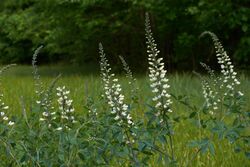Biology:Baptisia alba
| Baptisia alba | |
|---|---|

| |
| Baptisia alba var. macrophylla | |

| |
| Baptisia alba var. alba | |
| Scientific classification | |
| Kingdom: | Plantae |
| Clade: | Tracheophytes |
| Clade: | Angiosperms |
| Clade: | Eudicots |
| Clade: | Rosids |
| Order: | Fabales |
| Family: | Fabaceae |
| Subfamily: | Faboideae |
| Genus: | Baptisia |
| Species: | B. alba
|
| Binomial name | |
| Baptisia alba (L.) Vent.
| |
| Synonyms | |
|
Baptisia lactea (Raf.) Thieret | |
Baptisia alba, commonly called white wild indigo or white false indigo, is a herbaceous perennial plant in the bean family Fabaceae. It is native in central and eastern North America.[1] The plant is typically 2 to 3 feet (0.61 to 0.91 m) tall, but can be taller, with white, pealike flowers.
There are two varieties, Baptisia alba var. alba and Baptisia alba var. macrophylla.
Description
Leaves have alternate arrangement, and are trifoliate, narrow, and oblong.[2] White flowers occur from a long spike inflorescence. Blooming occurs from April to July, earlier in the southern part of the range.[3] The species is native to grasslands, but is grown in some gardens. It favors moist soils.[2]
Baptisia alba var. alba (syn. B. pendula) can be differentiated from B. alba var. macrophylla (syn. B. lactea and B. leucantha) on the basis that the former occurs only in the southeastern US and has fruits that hang downward when ripe.[4]
Baptisia alba is described as a facultative upland plant in all parts of its range.[5]
Ecology
B. alba is a host plant for caterpillars of the wild indigo duskywing butterfly and the indigo stem borer moth.[6] Bumblebees pollinate the flowers.[7]
Toxicity
The species can be fatal to cows that ingest the plant. It can cause irritation to humans and is possibly poisonous.[3]
References
- ↑ "Plants Profile for Baptisia alba (white wild indigo)". http://plants.usda.gov/java/profile?symbol=BAAL.
- ↑ 2.0 2.1 Denison, Edgar (2017). Missouri Wildflowers (Sixth ed.). Conservation Commission of the State of Missouri. pp. 32. ISBN 978-1-887247-59-7.
- ↑ 3.0 3.1 "Lady Bird Johnson Wildflower Center - The University of Texas at Austin". https://www.wildflower.org/plants/result.php?id_plant=BAAL.
- ↑ "Baptisia (False or Wild Indigo)". Clemson Cooperative Extension. https://hgic.clemson.edu/factsheet/baptisia-false-or-wild-indigo/.
- ↑ "Plants Profile for Baptisia alba (white wild indigo)". https://plants.usda.gov/core/profile?symbol=BAAL.
- ↑ "HOSTS - The Hostplants and Caterpillars Database at the Natural History Museum". https://www.nhm.ac.uk/our-science/data/hostplants/search/list.dsml?searchPageURL=index.dsml&Familyqtype=starts+with&Family=&PFamilyqtype=starts+with&PFamily=&Genusqtype=starts+with&Genus=&PGenusqtype=starts+with&PGenus=baptisia&Speciesqtype=starts+with&Species=&PSpeciesqtype=starts+with&PSpecies=alba&Country=&sort=Family.
- ↑ "White Wild Indigo (Baptisia alba macrophylla)". https://www.illinoiswildflowers.info/prairie/plantx/ww_indigox.htm.
Wikidata ☰ Q4857581 entry

